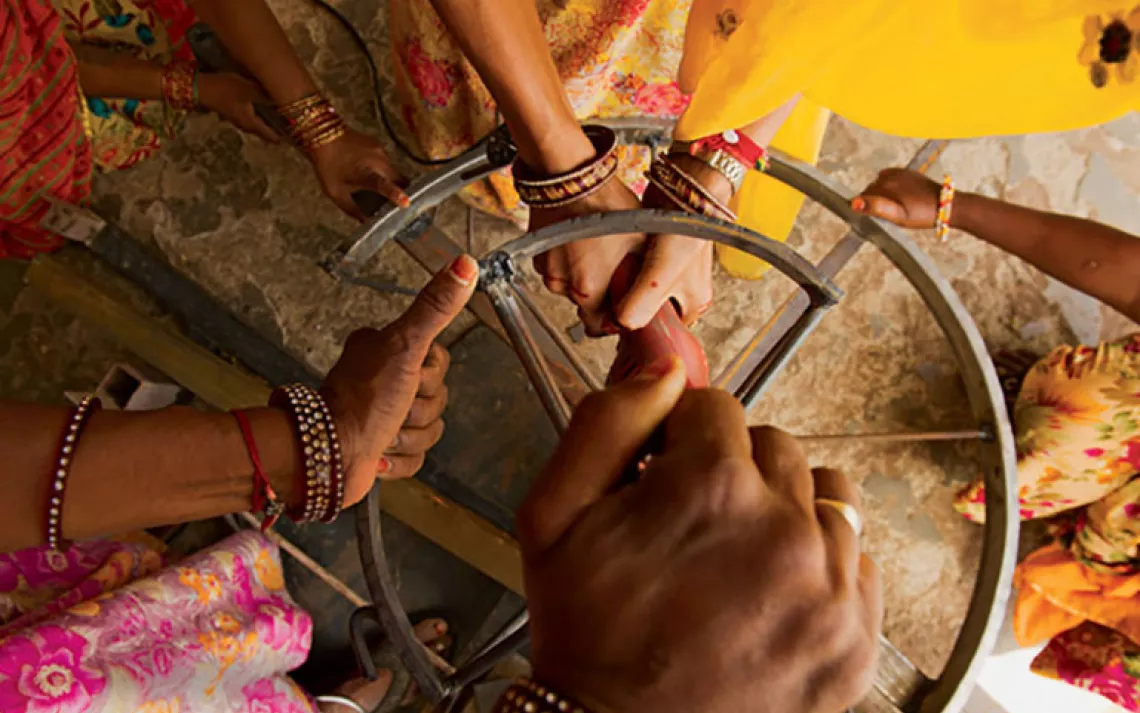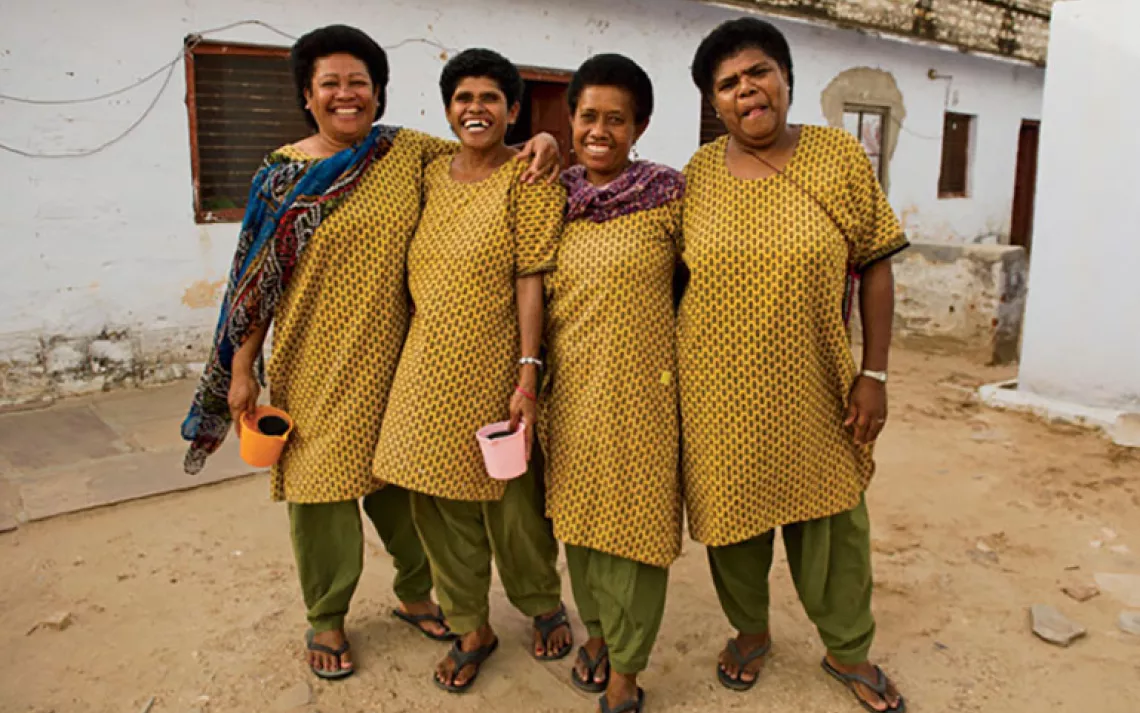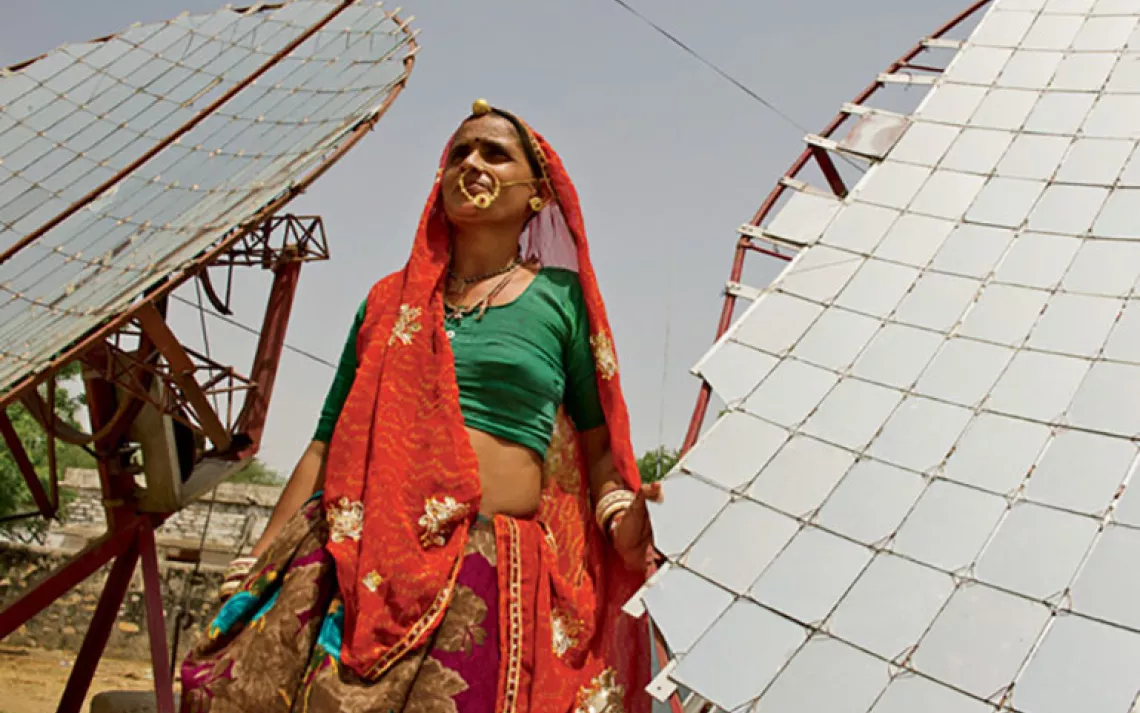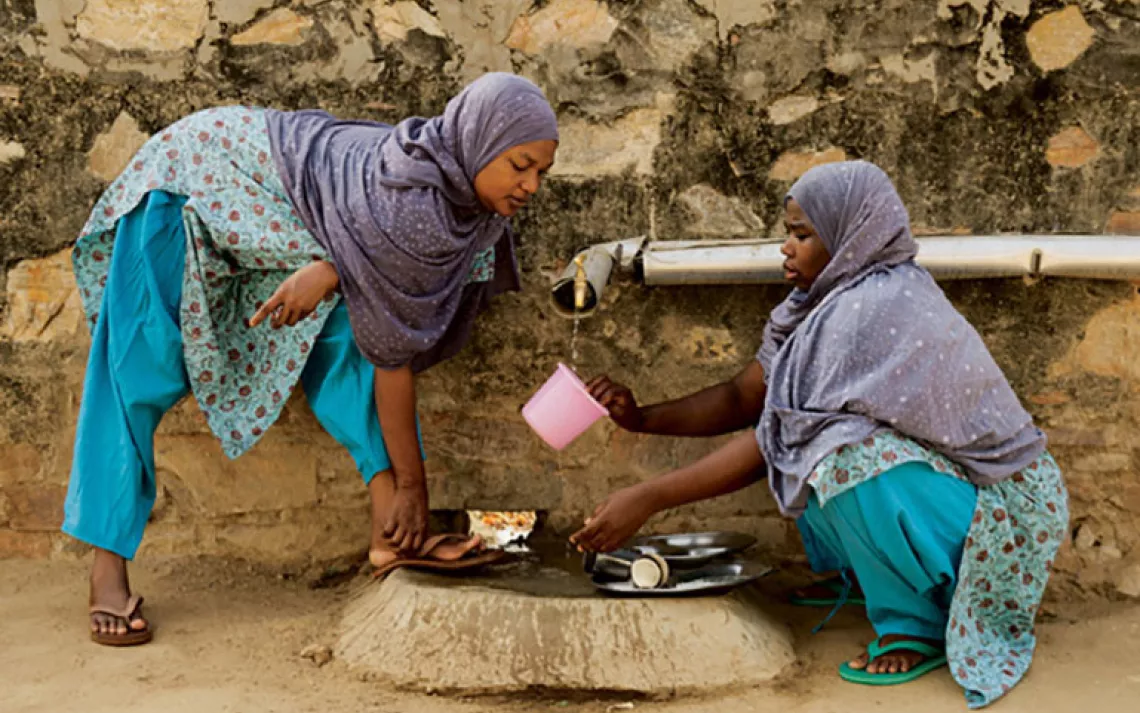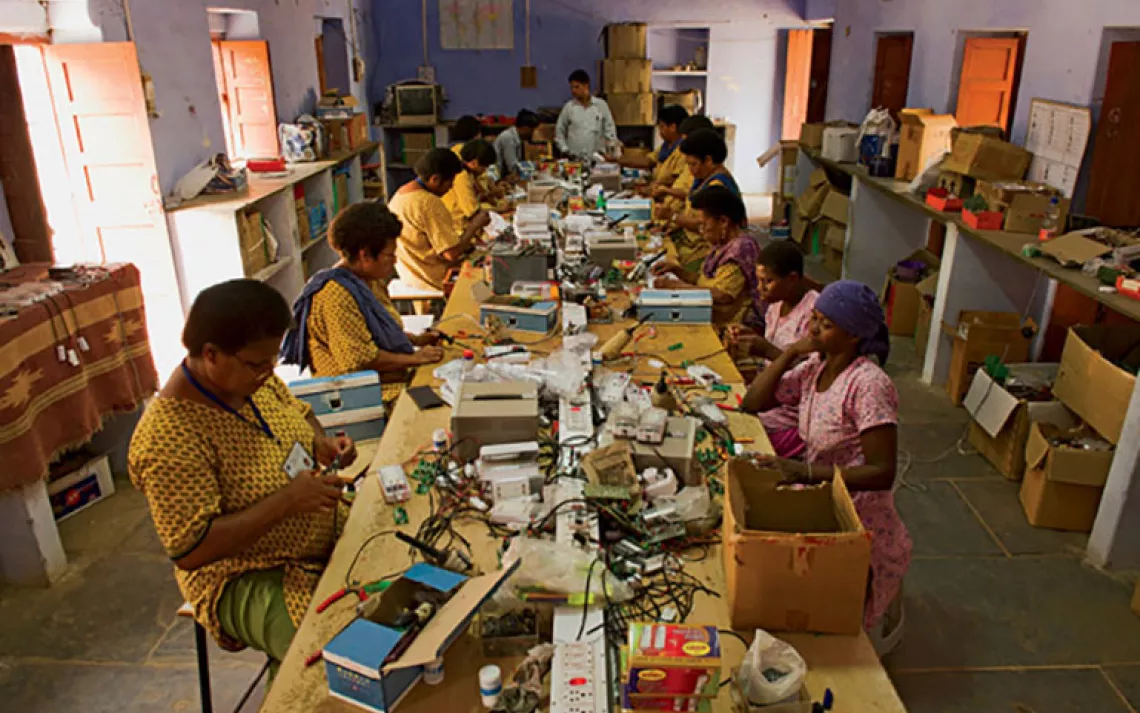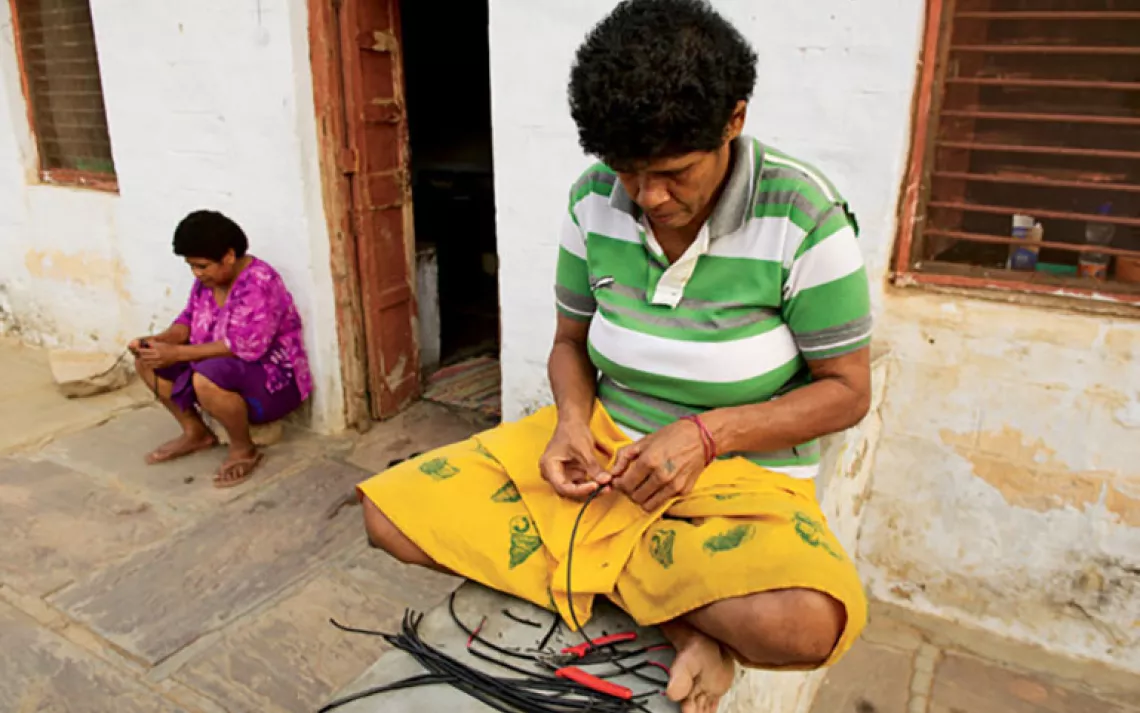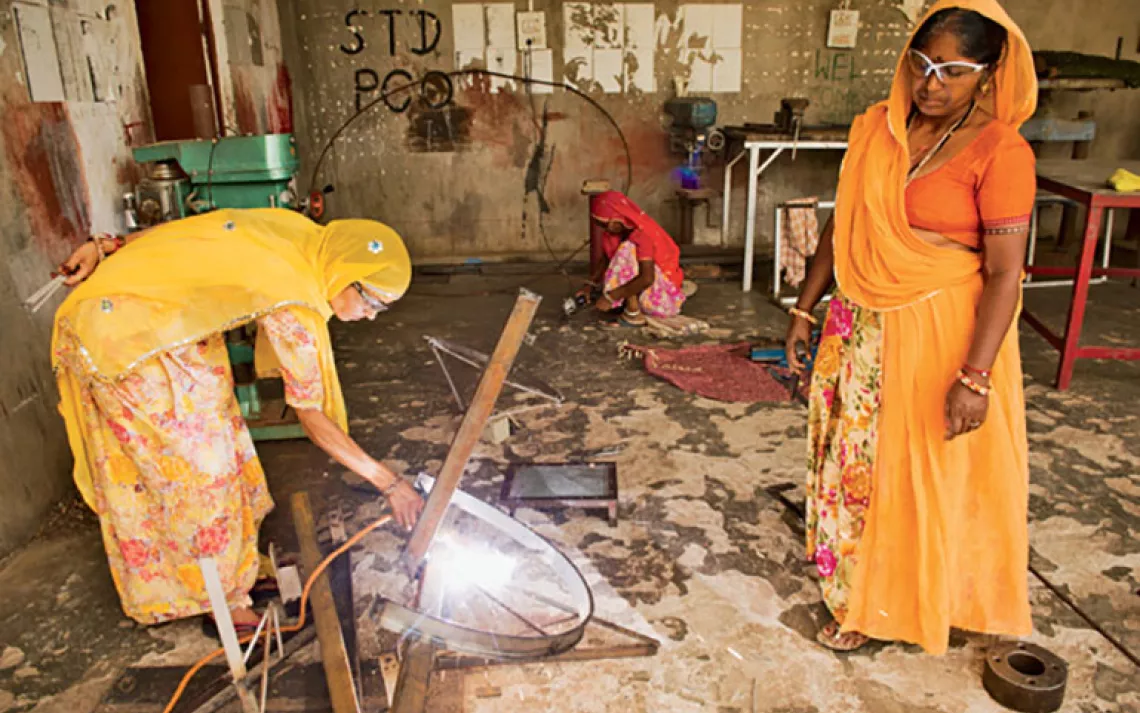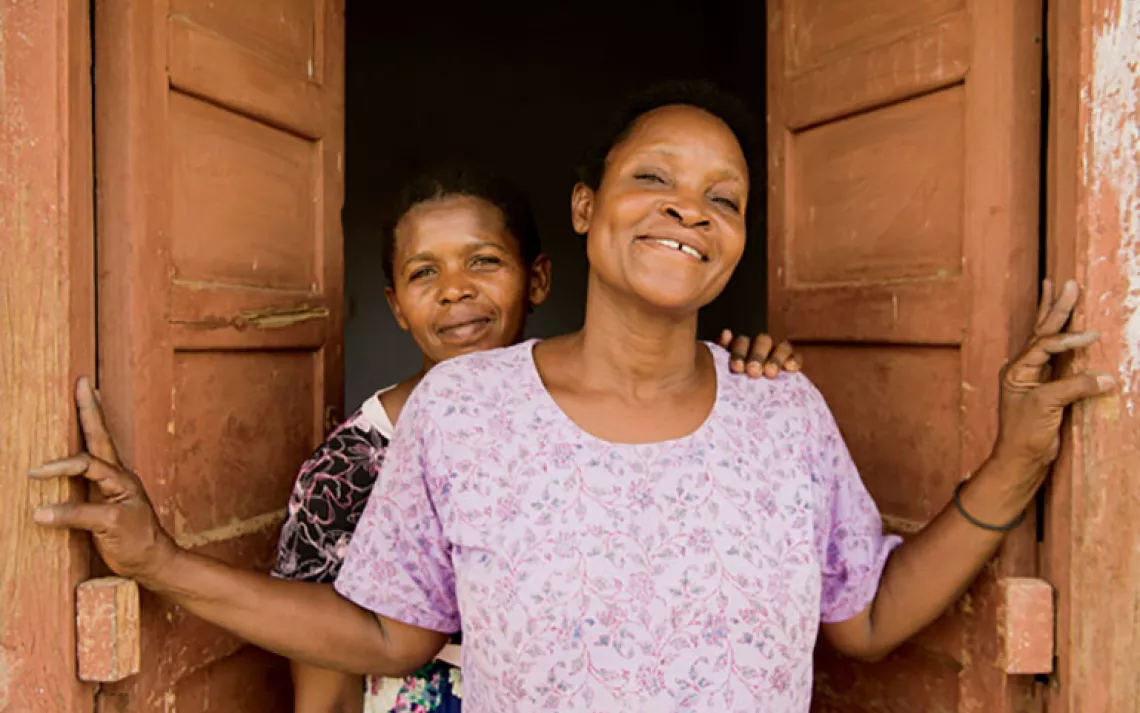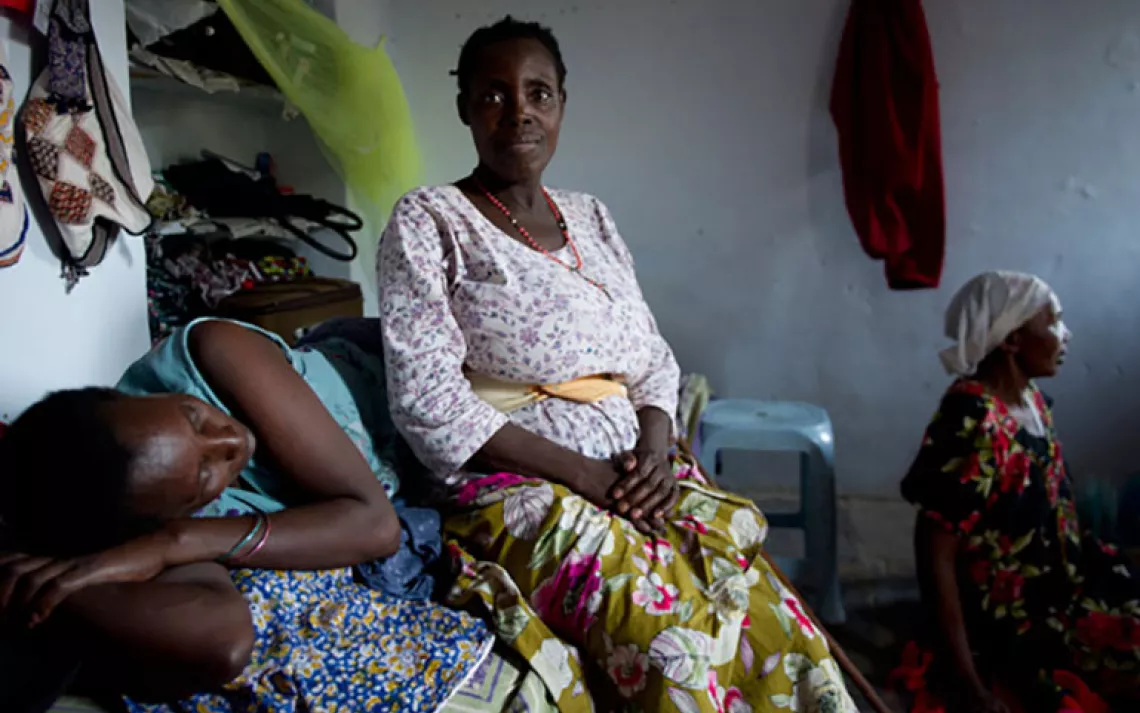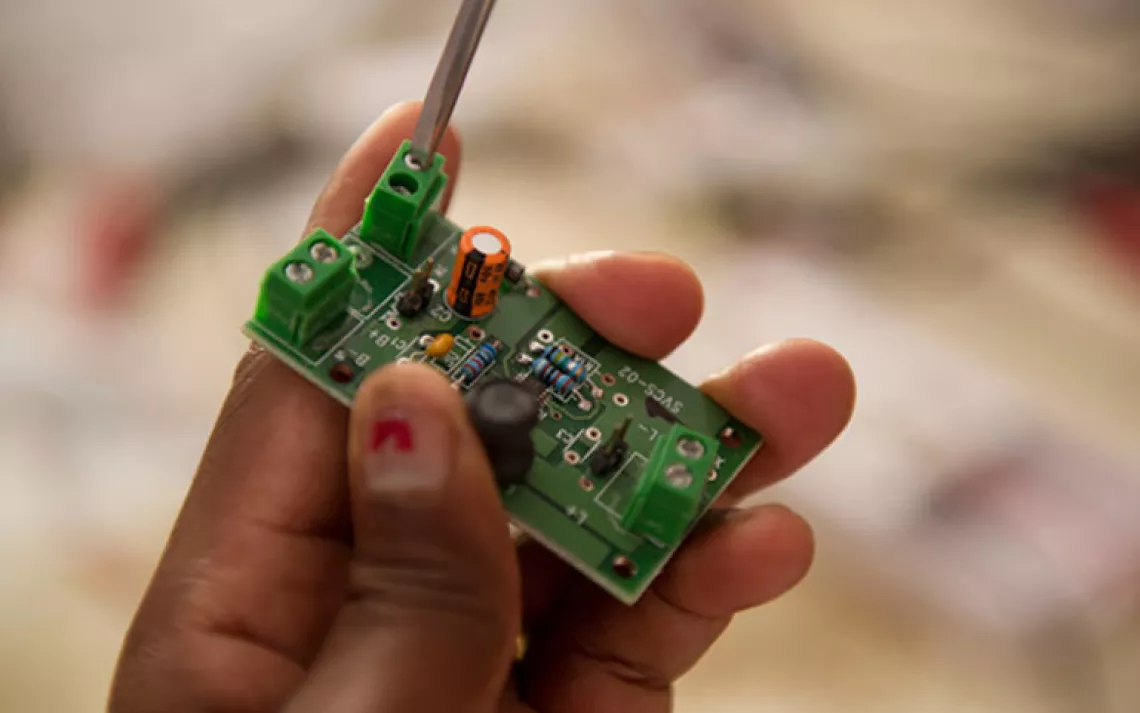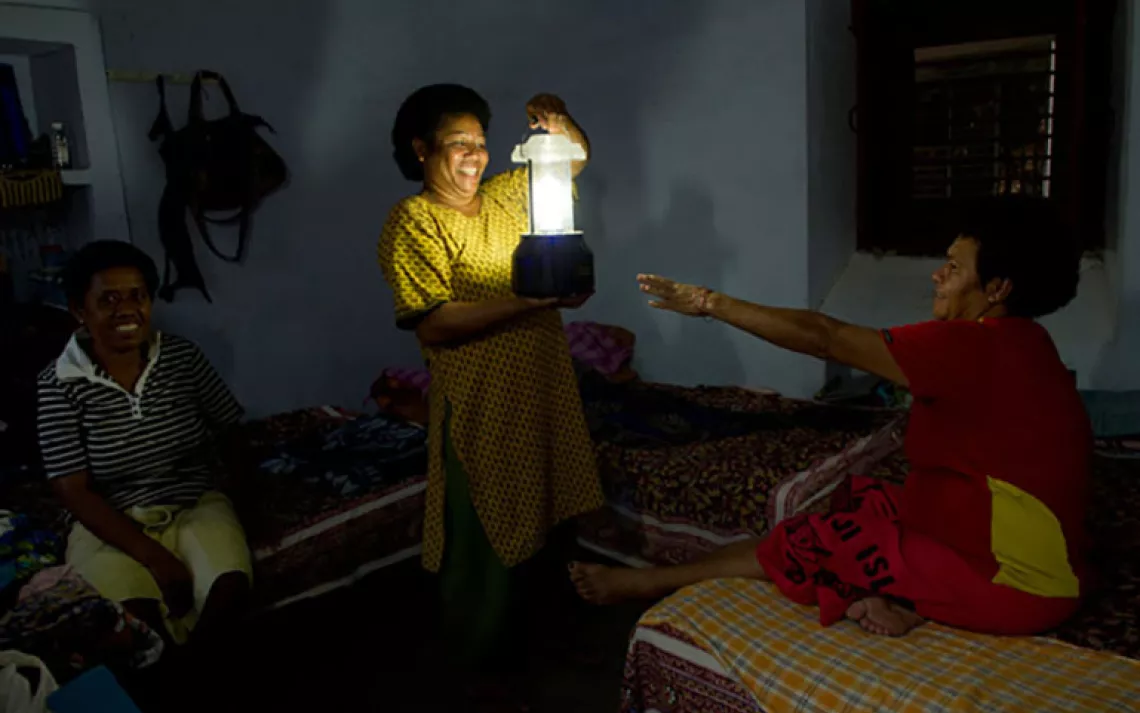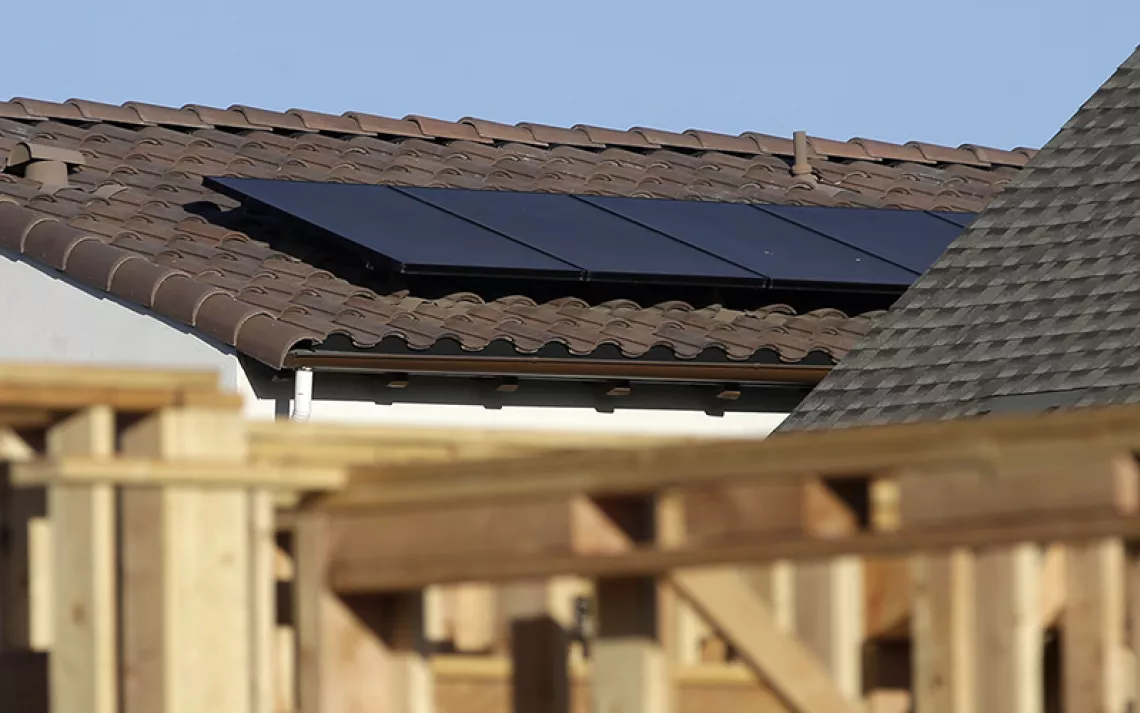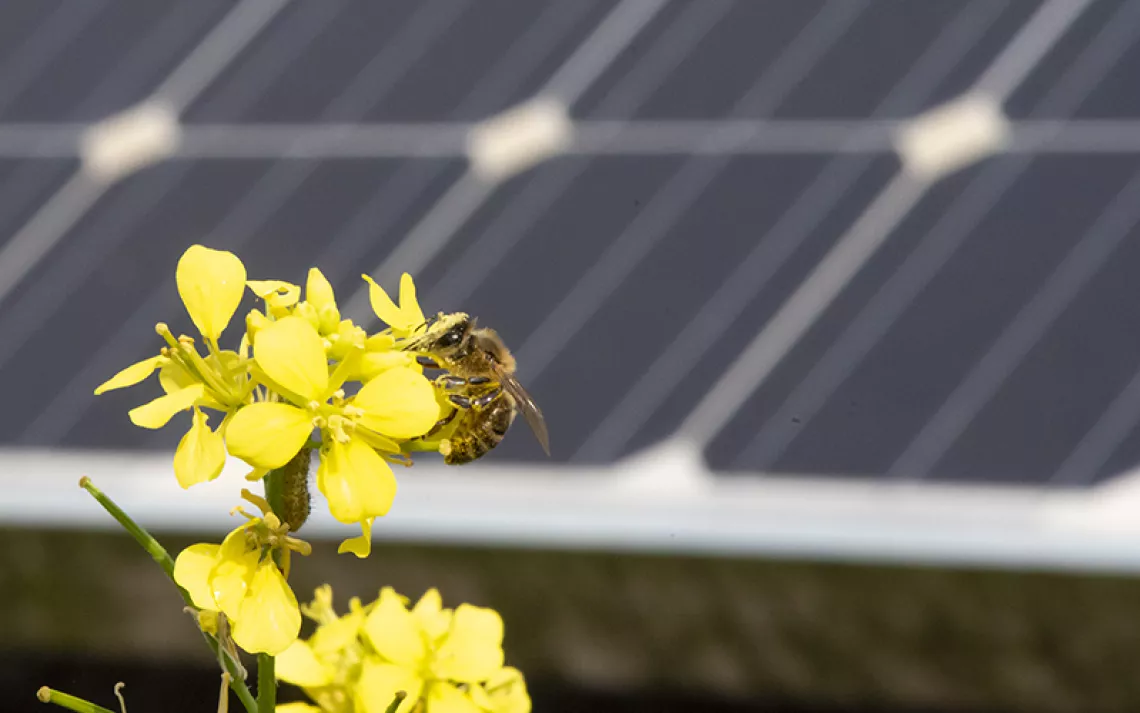India's Barefoot College
Rural mothers become solar engineers
The women come to India's Barefoot College from villages in Fiji, Peru, Rwanda, and beyond. They arrive largely unschooled and leave six months later as solar engineers, ready to electrify their worlds.
"Chai time." The tea is black, with lots of milk and sugar and a pinch of ginger and cardamom. It's well caffeinated, to get the students from Africa, South America, and Oceania through another eight-hour workday in the dry heat of northern India. The teachers—all locals—pour their chai into chipped cups hardly bigger than shot glasses. The Fijians use metal cups, maybe 12 ounces each. The Peruvians generally do not drink tea, because they suspect they are getting bigger from lack of exercise. The two women from Benin take their tea in quart-size, pink plastic pails originally intended for bathing, and they each stir in three tablespoons of sugar.
Again, teacher Manna Sharma says, "Chai time." But Miriama Moceiwasa, from Fiji, waves her off with a wire clipper, points to her malfunctioning lantern, and, in her limited English, says, "Make light."
There's a feeling of urgency in the classroom. Moceiwasa can sense it in the way the teachers test, bundle, and pack up the solar lights as soon as they're constructed. Over the past four days the students have built more than 600 of them, but Moceiwasa guesses that there's room in the boxes for more. Next week the lights will be shipped to the Liberian villages of eight former students.
Moceiwasa strips red insulation off an end of an electrical wire. Inside, there's another wire—thinner, copper, multi-stranded. Around the copper, she twists a soldering wire, which she then melts with a soldering iron to join the copper strands. She does the same with a black wire, then holds up both wires. "Red, positive. Black, negative," she explains, and connects them to a circuit board. The melting metal smells lousy, like burned hair spray.
I point to a resistor on a circuit board and ask her what it does.
She points to the same resistor and says, "It goes here."
Bahgwat Nandan, the coordinator of the solar program at the Barefoot College, later says, "Why does the solar light work? What scientific principles does it use? I still don't know. But it works."
Since 2004, the Barefoot College, in Tilonia, India, has trained about 250 illiterate and semiliterate women from rural, unelectrified villages in 41 countries to be solar engineers. After six months of training, these women have provided more than 15,500 houses with solar electricity in their home countries. The government of India covers all expenses—245,000 rupees (about $4,400) per woman, plus airfare. The college has trained an additional 700 men and women from rural India, including Moceiwasa's teachers.
The 34 students in Moceiwasa's class—all women—come from eight countries and have 137 children between them. On average, each has about six years of formal education. Seven of them can't read.
When she finally does take her tea, Moceiwasa brings it back to her stool at the end of one of the long worktables in the cinder block classroom. As she works, sweat rolls behind where her glasses meet her ears. She hunches over. It's May, one of the hottest and driest months in Tilonia. Today it is 105 degrees Fahrenheit.
Moceiwasa tests her light with a voltmeter, connecting a black wire to a black wire and a red to a red. But the light does not turn on.
So she frowns, finishes her tea, points to my empty chai cup, and says, "I take it, my daughter." Then she gets up and rinses my cup.
The face of the Barefoot College is Sanjit "Bunker" Roy, who, in an online TED video, wears traditional white pants (pyjamas), a burgundy shirt that goes down to his knees (kurta), and a vest with shades of brown layered like a geological cross section. He's confident and funny. ("What's the best way of communicating in the world today? Television? No. Telegraph? No. Telephone? No. Tell a woman.") He pauses at all the right times.
Roy has met with the Dalai Lama. He's won the World Technology Award for Social Entrepreneurship and the Sierra Club Environmental Award, among many others. In 2010, Time magazine named him one of the world's 100 most influential people.
Roy was the kind of kid you'd expect to see in Time one day. "I went through a very elitist, snobbish, expensive education in India," he says in the TED video. In 1965, at age 20, he won the first of three national squash championships, was attending St. Stephen's College in Delhi, and had recently graduated from the Doon School, a private boarding academy whose alumni include Rajiv Gandhi (the former prime minister of India) and Rajiv Dutta (the former president of Skype and PayPal).
That year, Roy traveled to Bihar, in northeastern India, to visit a rural village for the first time. He saw the early ugly effects of a drought that had caused a famine and that by 1967 would kill more than 2,300 people. Moved by the devastation, he found work in a water-starved village. He dug wells. "Mother went into a coma," he jokes in the video.
The more rural people Roy befriended, the more he got to thinking that the poor were strong enough and proud enough and good enough to raise themselves out of poverty. He reasoned that if the poor had access to schools that taught them the practical stuff they wanted to know (say, how to power their own villages) instead of what the urban elite thought they should know (say, how electrons and photons interact in a solar panel), they could build simple, self-sufficient, sustainable communities.
So Roy set out to create a rural college that would serve the poor--the 33 percent of Indians who, according to 2010 World Bank estimates, live below the international poverty line of $1.25 a day. In 1972, he opened the Social Work and Research Center--Barefoot College's official title--in an abandoned tuberculosis sanatorium on 45 acres of land that the government leased to the nonprofit for 1 rupee (about 2 cents) a month.
The lease was a short-term agreement. Government officials assumed that the urban college grad would soon flee a village of 2,000 in the desert. Forty years later, he still pays the 1 rupee, and the campus now has a medical clinic, a pathology lab, a library, a media room, a dining hall, a craft shop, a dairy shop, accounting offices, and dormitories whose roofs collectively harvest more than 100,000 gallons of rainwater per year and generate 50 kilowatts of solar energy. The college's 827 solar panels (plus one barrel of backup diesel fuel per month) power 500 lights, 100 fans, 30 computers, a deep freezer, and more. During the nine sunniest months of the year, the college prepares most meals on parabolic solar cookers, which are fabricated on campus by female welders who wear saris and sport geometric henna tattoos.
In the early years, Roy recruited a team of urban professionals to teach Tilonia's men. But the newly educated rural men almost always moved on to higher paying jobs in the city. So he brought in skilled local workers as teachers and began training women instead. "Why not invest in women, older women, mature women, gutsy women who have roots in the village?" Roy said to a CNN reporter last year.
To date, Barefoot College has trained about 15,000 women, most of them previously uneducated, to become teachers, construction workers, water testers, artisans, photographers, dentists, social activists, and solar engineers. The women, in turn, have brought basic services--such as water, light, education, and healthcare--to at least half a million people.
I ask to speak with Roy, but he's not in Tilonia and won't be back for another three weeks. Someone says that he might be at a conference in Australia or maybe in Africa, looking for the next class of solar students.
I e-mail Roy asking if he'll speak with me on Skype.
"But did you speak with Laxman Singh and Bhagwat Nandan and Bata?" he replies.
I write that I'd like to hear from him too, but Roy never responds, thus ensuring that this story won't be about him. In the TED video, he says, "Listen to the people on the ground. They have all the solutions in the world."
***
To inspect the light that won't yet light, Sharma pulls up a stool alongside Moceiwasa. "No light, no go Fiji!" Sharma jokes.
"Light! Fiji!" says Moceiwasa. She flicks her eyebrows up twice, as the Fijians often do to punctuate an important point. Moceiwasa is a farmer's wife and a mother to seven children. Two months ago, in March, she left Fiji for the first time. In mid-September, she'll return with a practical understanding of solar technologies that she'll use to electrify her off-grid village. Maybe one day she'll train other Fijians to do the same.
A few stools down, Yoro Dakou, from Benin, is stripping a wire with her teeth. It must be because her wire stripper has broken or dulled. Moceiwasa says that at the beginning of the program, the two women from Benin would scream and cry, and she couldn't figure out why. No one seems to know what language they speak. In Benin's profile in the college's official records, it says, "Language: No."
The Fijians speak a little English, a result of British colonization, and the teachers speak even less. But after two months of study, all the students and teachers have cobbled together a shared vocabulary: resistance, diode, PCB (though most don't know that it stands for printed circuit board), LED, wire cutter, wire stripper, copper wire, soldering wire, heat sink, connection problem, light. They know colors and numbers in English because colors and numbers determine the placement of circuit components. (Each resistor has four or five color bands, and each color corresponds with a number that represents how many ohms that particular resistor resists, and that indicates which resistor goes where on the PCB. Mess up the placement, and the light won't light.) During the first month of the program, the students and teachers repeated all these words out loud, together, until the names stuck.
In Hindi, the students understand namaste (hello and goodbye), garam garam (very hot), soi soi (very sleepy), and nacha nacha (dance).
"Connection problem," Sharma says, pointing to the circuit and handing the light back to Moceiwasa, who nods and re-solders the circuit's two connecting wires. Black to black, red to red. She tests it again, and the light turns on. This 12-volt light will connect to a charge controller, which, in turn, will connect to a battery and a solar panel. For a monthly salary paid for by the village, Moceiwasa will install three of these lights and one lantern in her neighbors' houses. If maintained properly, the system should function for more than 10 years, though the battery will need to be replaced every 5 to 6 years.
Sharma coughs.
Moceiwasa turns around to look at her.
Sharma rubs her throat. "Connection problem."
Moceiwasa's forehead furrows. "Problem. Sick." They've understood each other.
***
In a region where child marriage persists and where two out of three women are sent away to tend to their husbands by the age of 18--before they have the opportunity to wonder who they are or who they might one day become--the Barefoot College is breaking tradition. Here, five of the eight solar teachers are women. Sharma, 30, learned solar mechanics in 2009 and began teaching last year. She has "two children, cut-cut," she says, making cutting motions over both fallopian tubes. (To this, Moceiwasa squints and says, "Why?")
Two of the teachers have physical disabilities. I ask teacher Govardhan Gopal if his deformed foot (a result of polio) has brought on challenges, but he does not seem to understand what I'm asking or, maybe, why I'm asking it. In Hindi he says, "This is just how my leg is. It has been like this since I was one." At Barefoot, those with one bad leg use wooden crutches. Those with two bad legs get around using hand cycles and arm strength. Of the college's 200 workers, about 35 are physically challenged.
Teacher Kailash Chand is young and strong and male and 16 hours by bus from home. In his town of Dhanua, Rajasthan, he installed 1,000 lights after training at the college back in 2000. Over chai, Chand leans into the shadow of a neem tree and clicks through his cellphone photos--all of a baby with brown eyes and cheeks so big that they look like they're storing a stack of chapatis. "Vandana looks like me." Vandana and her brother and mother still live in Dhanua, as Chand's father wouldn't let his little granddaughter leave. Chand misses them.
As a textile worker in Dhanua, Chand earned as much as he does now--20 percent above minimum wage, or about $3 per day. (To promote equality, no one at Barefoot earns more than $100 per month.) He says that he is still here, far from his family, because "Barefoot College does good" and did good for Dhanua.
Chand is the one who, from time to time, turns on the TV. Officially, there are no televisions for recreational purposes on campus, but there is the 21-inch television in the southern corner of the solar classroom, beneath a white tablecloth turning sallow from the sun. The TV powers up with a gentle sneeze. All of a sudden, the students are looking at a playing field that's impossibly green--brighter than any desert shrub, jungle green.
"Rugby!" the Fijians say.
It's cricket. Mid-match, Chand turns to the women and asks, "Machli?"
"Machli!" the Fijians yell. Moceiwasa takes off her reading glasses. Chand switches to the Discovery Channel, which is showing a lake. The water is rippling, suggesting moving bodies underneath.
In Hindi, machli means "fish."
Back home, in Kadavu Island's mangrove forests and fringing coral, Moceiwasa catches emperor fish and skipjack tuna. Her son spears sharks. "My home smells like coconut milk and mangoes and piglets." The weather is "regular."
No roads or power lines lead to the village of Naioti. Of its 34 houses, 28 sit empty, abandoned by locals who escaped to the city. Suva, Fiji's capital, lies about 55 miles north by boat, or as Moceiwasa says, "Forty-five dollars away, each person, each way." She never aspired to a life in the city, where, she says, "you need money to eat and then you need money to go to the toilet." Her husband's crops bring in 500 Fijian dollars (about US$280) annually. Half of that she spends on kerosene.
As a child, Moceiwasa wanted to marry a farmer because her father was a farmer, and then she did marry a farmer, and so did three of her daughters. Each of her 51 years passed by in much the same way as the one before it. She boiled fish. Pulled up yams. Wove coconut-leaf mats and fans. For more than two decades, she volunteered as her village's only health worker. For stomachaches, she prescribed the leaves of the physic nut tree. For coughs, rough lemon leaves.
"Only God paid me."
She is ordinary and proud. Her island still has clean blue seas, more than 75 percent of its forests, and a population of about 10,000. On Kadavu, it's easy to question the dogma of progress.
She won't talk about Kadavu's mosquitoes or about the loneliness of her village's empty plywood houses. Shewon't say a word against her husband. At a distance of 7,500 miles, her sunny memory of home brightens whatever its reality might be. (Similarly, the Chileans speak dreamily of their coastal cliffs, the Peruvians of their mountains.)
Moceiwasa left for the Barefoot College because her children encouraged her to go (they wanted her to see the Taj Mahal), her neighbors complained about rising kerosene prices (a 26 percent increase from 2005 to 2008), and her husband gave her permission.
Moceiwasa and her fellow countrywomen speak most comfortably in the first-person plural, as in, "We Fiji women are Christian women."
"We Fiji women come from paradise."
"We Fiji women are sick of this curry and chapati."
***
Moceiwasa is sitting in front of an air cooler that sounds like a plane taking off when, suddenly, the classroom's solar generators turn off. Her soldering iron cools. So she lies facedown on two stools and says, "I am not here, my daughter." The classroom quiets. The air thickens.
It's late in the afternoon. Little plastic bags that just this morning contained circuits and switches now billow out the back door, past the chipped water bowl that's tied up into a tree with used electrical cables. Through the dry summer, the bowl hydrates woodpeckers, babblers, and mynahs.
Beneath the bowl, there's Reapi Vaitalea from Fiji, punching the digits of her cellphone. Ants crawl between her toes. She paces through sand prints of plastic flip-flops and bare feet and leather jutti—traditional local shoes that protect feet from snakes and scorpions.
When Vaitalea returns to the classroom, she announces, "No network connection," and the women collectively groan.
Then Moceiwasa sits up. She drums her fingers against the workbench. Lautaini Nabua, the Fijian across the table from her, joins in.
"Meda mai taura tale na bogi," the two women sing. By "tale," all 10 Fijians have joined in, dividing themselves into altos and sopranos.
"Let's dance in the night," they repeat in Fijian.
Vaitalea spins around and bangs a plastic Fanta bottle against her thigh. At the other end of the room, the four women from Rwanda add a stomp. The two from Burundi play imaginary zithers. Sharma sticks bindis (traditional Indian dots) on unsuspecting foreheads. Peruth Masoyinyana, from Rwanda, yells out the colors in English, adding an "ah" to the end of words and squeezing "en" between them: "Red-ah en yellow-ah en blue-ah."
When the song ends, the women sit back down. Slump forward. It's 5 p.m. "Class finished."
Moceiwasa packs her things into a cardboard box that once stored circuits for charge controllers. Inside the box, there's a roll of black tape, a cellphone, a dozen grape-size pink pills, some white pills the size of sesame seeds, a rag smeared in thermal grease, a wire stripper, and red and black electrical wires that she intends to strip after dinner and again before breakfast, to get ahead for tomorrow's class.
"Dinnertime," someone says.
This is when the Fijians declare, "We Fiji women are sick of this curry and chapati!" (The others seem to agree. The Africans often skip meals, and the South Americans whisper to the goats loitering outside the classroom, "In my country, we would eat you.")
On her way out of the classroom, Moceiwasa turns to me and says, "But we did not come for the food. We came for the solar engineering."
***
The following week, Moceiwasa's family calls to say that one of her daughters just gave birth to her first baby—a girl. On the same day, the solar lights that Moceiwasa and her fellow students recently constructed are packed in cardboard boxes and stacked under a yellow tarp in a truck painted all of the colors that the desert is not.
The truck carries 314 home lighting systems—each containing three lights, a lantern, and a mobile charging station—and four big packages of tools and spare parts. Chand will be the one driving the truck north to the city of Jaipur. From Jaipur, the lights will travel to Mumbai by rail, then byship around Africa to Liberia, then in another truck into the backcountry, where eight solar engineers—with no years of schooling and 45 children between them—will soon do something for their villages that they once could not do.
MORE
Solar Mamas: An inspiring film about one woman's attempt to light up her world.
 The Magazine of The Sierra Club
The Magazine of The Sierra Club
